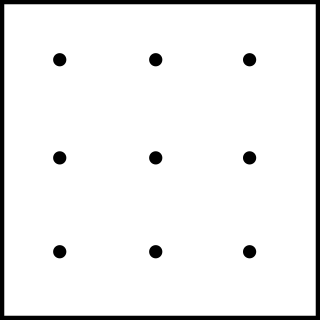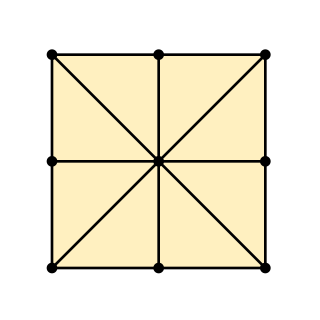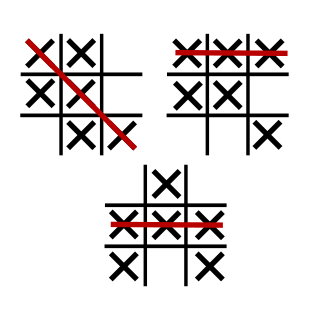
Tic-tac-toe, noughts and crosses, or Xs and Os is a paper-and-pencil game for two players who take turns marking the spaces in a three-by-three grid with X or O. The player who succeeds in placing three of their marks in a horizontal, vertical, or diagonal row is the winner. It is a solved game, with a forced draw assuming best play from both players.

Nine men's morris is a strategy board game for two players dating at least to the Roman Empire. The game is also known as nine-man morris, mill, mills, the mill game, merels, merrills, merelles, marelles, morelles, and ninepenny marl in English. The game has also been called cowboy checkers and is sometimes printed on the back of checkerboards. Nine men's morris is a solved game, that is, a game whose optimal strategy has been calculated. It has been shown that with perfect play from both players, the game results in a draw.

Fanorona is a strategy board game for two players. The game is indigenous to Madagascar.
Three men's morris is an abstract strategy game played on a three by three board that is similar to tic-tac-toe. It is also related to six men's morris and nine men's morris. A player wins by forming a mill, that is, three of their own pieces in a row.

3D tic-tac-toe, also known by the trade name Qubic, is an abstract strategy board game, generally for two players. It is similar in concept to traditional tic-tac-toe but is played in a cubical array of cells, usually 4x4x4. Players take turns placing their markers in blank cells in the array. The first player to achieve four of their own markers in a row wins. The winning row can be horizontal, vertical, or diagonal on a single board as in regular tic-tac-toe, or vertically in a column, or a diagonal line through four boards.

Dara is a two-player abstract strategy board game played in several countries of West Africa. In Nigeria it is played by the Dakarkari people. It is popular in Niger among the Zarma, who call it dili, and it is also played in Burkina Faso. In the Hausa language, the game is called doki which means horse. It is an alignment game related to tic-tac-toe, but far more complex. The game was invented in the 19th century or earlier. The game is also known as derrah and is very similar to Wali and Dama Tuareg.

Nine Holes is a two-player abstract strategy game from different parts of the world and is centuries old. It was very popular in England. It is related to tic-tac-toe, but even more related to three men's morris, Achi, Tant Fant, Shisima, Picaria, and Dara, because pieces are moved on the board to create the 3 in-a-row. It is an alignment game.

Achi is a two-player abstract strategy game from Ghana. It is also called tapatan. It is related to tic-tac-toe, but even more related to three men's morris, Nine Holes, Tant Fant, Shisima, and Dara, because pieces are moved on the board to create the 3-in-a-row. Achi is an alignment game.

Tant Fant is a two-player abstract strategy game from India. It is related to tic-tac-toe, but more closely related to three men's morris, Nine Holes, Achi, Shisima, and Dara, because pieces are moved on the board to create the 3 in-a-row. It is an alignment game.
Shisima is a two-player abstract strategy game from Kenya. It is related to tic-tac-toe, and even more so to three men's morris, Nine Holes, Achi, Tant Fant, and Dara, because pieces are moved on the board to create the 3-in-a-row. Unlike those other games, Shisima uses an octagonal board.
Tsoro Yematatu is a two-player abstract strategy game from Zimbabwe. Players first drop their three pieces onto the board, and then move them to create a 3 in-a-row which wins the game. It is similar to games like Tapatan, Achi, Nine Holes, Shisima, and Tant Fant. However, what makes this game unique is that pieces can jump over each other which adds an extra dimension in the maneuverability of the pieces.
Wali is a two-player abstract strategy game from Africa. It is unknown specifically which African country the game originates from. Players attempt to form a 3 in-a-row of their pieces, and in doing so capture a piece from their opponent. The game has two phases: Drop Phase and Move Phase. Players first drop as many of their pieces as possible in the Drop Phase, then move them to form 3 in-a-rows which allows them to capture the other player's pieces in the Move Phase.
Zamma is a two-player abstract strategy game from Africa. It is especially played in North Africa. The game is similar to Alquerque and draughts. Board sizes vary, but they are square boards, such as 5x5 or 9x9 square grids with left and right diagonal lines running through several intersection points of the board. One could think of the 5x5 board as a standard Alquerque board, but with additional diagonal lines, and the 9x9 board as four standard Alquerque boards combined, but no additional diagonal lines are added. The initial setup is also similar to Alquerque, where every space on the board is filled with each player's pieces except for the middle point of the board. Furthermore, each player's pieces are also set up on their respective half of the board. The game specifically resembles draughts in that pieces must move in the forward directions until they are crowned "Mullah" which is the equivalent of the king in draughts. The Mullah can move in any direction. In North Africa, the black pieces are referred to as men, and the white pieces as women. In the Sahara, short sticks represent the men, and camel dung represent the women.

Zillions of Games is a commercial general game playing system developed by Jeff Mallett and Mark Lefler in 1998. The game rules are specified with S-expressions, Zillions rule language. It was designed to handle mostly abstract strategy board games or puzzles. After parsing the rules of the game, the system's artificial intelligence can automatically play one or more players. It treats puzzles as solitaire games and its AI can be used to solve them.
Indian and jackrabbits is a two-player abstract strategy board game from the Tiwa tribe of Taos, New Mexico. A similar game with a slightly different board is also played by the Tohono O'odham tribe of Arizona. From the outset, these games look like hunt games similar to Catch the Hare, the Fox games of Europe, and the tiger and leopard games of Asia, because they use very similar boards, and the game mechanics are the same, and the number of pieces each player controls is different. However, they are not the same games, because the goals are completely different. The goal of the one Indian is to capture just one of the twelve jackrabbits. The goal of the jackrabbits is to move themselves safely onto the other side of the board mirroring their initial positions.
Tiger and buffaloes is a two-player abstract strategy board game from Myanmar. It belongs to the hunt game family. The board is a 4x4 square grid, where pieces are placed on the intersection points and move along the lines. It is one of the smallest hunt games. Three tigers are going up against eleven buffaloes. The tigers attempt to capture as many of the buffaloes by the short leap as in draughts or Alquerque. The buffaloes attempt to hem in the tigers.
Mojo is a two-player, 3 in-a-row abstract strategy board game played with original and unique "thrice-sliced-dice". The pieces, handmade to order in India, are colored with non-toxic vegetable dye. The individual opposite ends of the pieces are marked with pips and numbered similar to regular dice - i.e. they total 7. It takes all 3 pieces of a color to make up a single die.

Chesquerque is a chess variant invented by George R. Dekle Sr. in 1986. The game is played on a board composed of four Alquerque boards combined into a square. Like Alquerque, pieces are positioned on points of intersection and make their moves along marked lines ; as such, the board comprises a 9×9 grid with 81 positions (points) that pieces can move to.

Tic-tac-toe is an instance of an m,n,k-game, where two players alternate taking turns on an m×n board until one of them gets k in a row. Harary's generalized tic-tac-toe is an even broader generalization. The game can also be generalized as a nd game. The game can be generalised even further from the above variants by playing on an arbitrary hypergraph where rows are hyperedges and cells are vertices.











